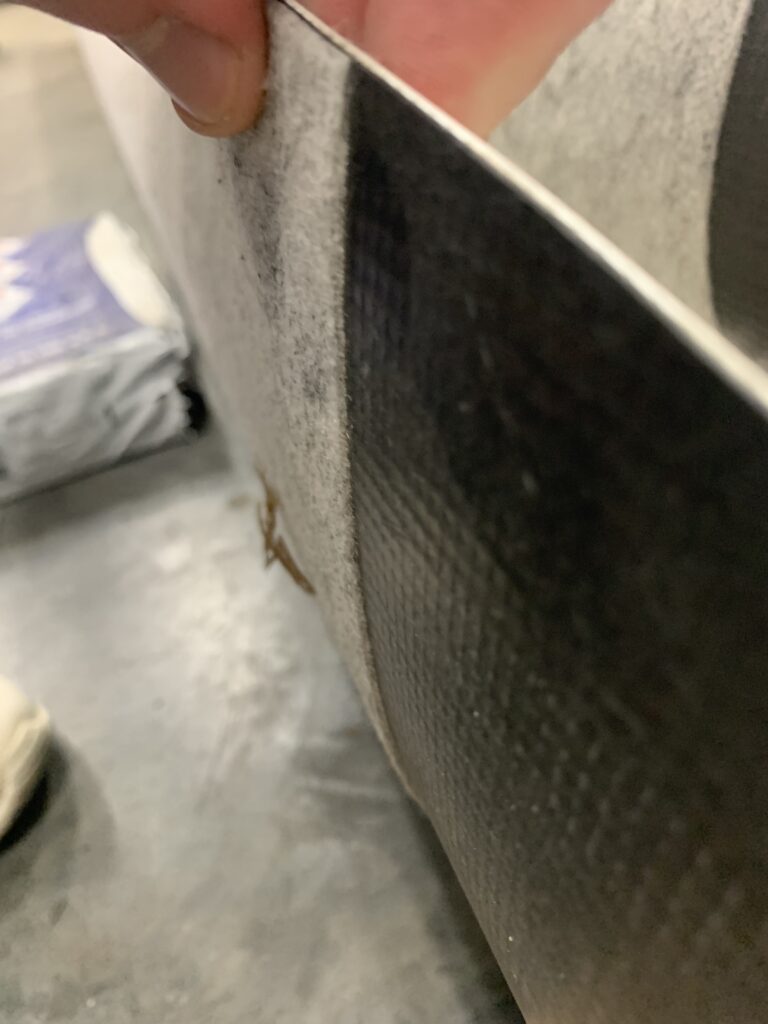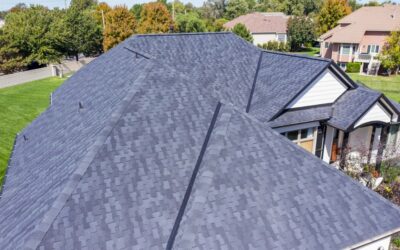Do you have an aging flat or low slope commercial roof? Maybe your modified bitumen roof looks more like an alligator’s back than you would like — cracking, blistering, peeling, and pulling away. Or maybe you own and manage an older building that has been through a violent hailstorm, and your building needs urgent repairs. Whatever your situation, if you have a worn-out flat or low slope commercial roof, you might consider covering it with a fleeceback waterproof membrane like fleecebacked TPO, PVC, or EPDM. What do all these letters mean? In this article, we’ll parse through the abbreviations and walk through the benefits and drawbacks of each one. You’ll know which standard membrane or fleeceback membrane might be the right solution for your flat or low slope commercial building.

Which Waterproofing Membranes Are Used in Low-Slope Commercial Roofing?
TPO, PVC, and EPDM are all different types of single-ply waterproofing membranes that are used as the top layer of a roofing system. They are all designed to keep the water and elements out and keep your building dry. Each has its own unique advantages and disadvantages, and each one can be a great option for different roofs in different situations. Each one comes in a standard version (non-fleeceback) and a fleeceback version. Below is a brief summary of the membrane options you’re likely to encounter for your commercial roof.
What is TPO?
TPO (thermoplastic polyolefin) is a white, single-ply waterproofing membrane that is used as the top layer of a roofing system. TPO has become the preferred waterproofing membrane for flat and low slope commercial roofs, especially if they are not visible from the street or over elevated windows. Other features include:
- Cost Effective: TPO is generally available at a lower price than other membranes.
- Thicknesses: It’s available in 45, 60, and 80 mil thicknesses.
- Minimizes Operational Disruptions: If it is laid over an existing roof, there is no need to tear the roof open and disrupt business operations.
- Fastening Methods: It can be either mechanically attached (screwed down using plates and long screws) or it can be fully adhered (using special glues and adhesives).
- Fast: It is relatively fast to install.
- Durability and Hail Resistance: It’s durable and hail resistant due to its elastic properties.
- Energy Cost Savings: Your energy bill will decrease after installing a bright white TPO membrane because it is going to reflect more of the sun’s rays, keeping your roof and entire building noticeably cooler for the first few years after installation.
- Warranty: A well-installed TPO system is an investment in your company’s future. A new TPO roofing system will typically come with a 20-year manufacturer’s warranty on the materials.

What is PVC?
PVC (polyvinyl chloride), similar to TPO, is a white, single-ply waterproofing membrane that is used as the top layer of a roofing system to keep the water and elements out. It is made from two layers of polyvinyl chloride with a polyester mesh in between. PVC is quickly becoming the preferred waterproofing material for flat and low slope restaurant and manufacturing roofs, because PVC is much more resistant to acids, animal fats, super-heated grease, and other emissions from manufacturing. Other features include:
- Cost: Although not as cost-effective as TPO, it is still a good option given its long lifespan and durability.
- Thicknesses: PVC is available in 45, 60, and 80 mil thicknesses.
- Minimizes Operational Disruptions: If it is laid over an existing roof, there is no need to tear the roof open and disrupt business operations.
- Fastening Methods: It can be either mechanically attached (screwed down using plates and long screws) or it can be fully adhered (using special glues and adhesives).
- Fast: It is relatively fast to install.
- Durability and Hail Resistance: it’s durable and hail resistant due to its elastic properties.
- Energy Cost Savings: Your heating and cooling bills will be lower after the addition of a bright white PVC membrane, because it is going to reflect a lot more of the suns rays, keeping your roof and entire building noticeably cooler.
- Warranty: Just like a well-installed TPO system, a properly installed PVC roofing system is an investment. Your new PVC roofing system will typically come with a manufacturer’s warranty of up to 25 years.
- Great for Restaurants and Manufacturing: PVC is naturally fire resistant and can stand up much better to the animal fats and super-heated grease that restaurants produce. It can also withstand acids and other corrosive chemicals produced by manufacturing.
What is EPDM, and What Are its Drawbacks?
EPDM (ethylene propylene diene monomer) is a synthetic rubber roofing membrane that is derived from natural gas and oil. Although not as popular as TPO and PVC, it was commonly used prior to TPO’s proliferation. Although EPDM has a long track record and is usually relatively affordable, it is not as popular because it comes with some drawbacks that TPO and PVC do not have.
- Black Absorbs the Heat: EPDM traditionally comes in black, which, as we discussed in the article on TPO vs Modified Bitumen, it absorbs the majority of the sun’s UV rays and radiant energy, leading to a hotter roof, a hotter building, and the Urban Heat Island Effect.
- Not Environmentally Friendly: With a black EPDM roof, building owners will have to pay more for cooling costs in the summer. This can also contribute to rolling blackouts in major metropolitan areas.
- Not As Durable: EPDM can become fragile and shrink as it nears the end of its life, which makes it prone to leaks as it ages.
- Aesthetics: Many people consider EPDM to be less attractive than other roofing materials. If your building’s roof is visible from the street or overhead windows, this might not be the best choice for your roof.
What Is Fleecebacking?
Fleeceback membranes are heavy-duty versions of standard membranes. They comprise non-woven polyester strands, or geotextiles made from recycled plastics like a bottle of soda.
If you’ve ever poured a concrete pad, you likely installed a plastic vapor barrier between the ground and the pad. This vapor barrier helps keep the concrete thickness consistent, much like the fleece lining keeps the membrane from sagging over small sags in the roof decking.
Rebar and fiberglass in concrete helps keep the pad in one piece by providing lateral strength. Each fiber provides resistance to the pressure that is generated when a crack develops. The fleece fibers provide a similar function for the membrane, providing support wherever it is needed.

Fleece Backing

Fleeceback Close-Up Cross-Section

Fleeceback and Standard Backing Compare
What are the Advantages of Fleeceback Roof Membranes?
TPO, PVC, and EPDM are also available in fleeceback options. Fleeceback is exactly what it sounds like. A 55-mil layer of fleece is adhered to the backs of these membranes by the manufacturer. This extra layer of fleece makes all of these membranes thicker, more durable, and better able to stand up to hail and impacts.
Before reviewing the advantages of fleeceback membranes, it’s important to note that fleeceback membranes have a higher material cost, although the installation cost will be roughly the same. Comparing standard membranes to fleecebacked membranes isn’t comparing good to great, but rather great to excellent.
Opting for a fleece lined flat roof membrane should be a practical decision and viewed as an investment. If the budget permits, investing in a fleeceback flat roof membrane will provide many advantages.
- Increased Durability: Fleeceback membranes (TPO, PVC, and EPDM mentioned above) are more durable and hail-resistant than standard membranes. The 55-mil fleece liner that is adhered to the back of the membranes adds increased durability, so much so that it is not necessary to place a cover board under them (as is traditionally required in other roofing systems). This allows the building owner to save on materials costs.
- Hail Resistance: When hail strikes fleeceback membranes, it just bounces off due to the additional thickness and stability provided by the fleece layer. Fleeceback membranes can stand up to heavy foot traffic and wind pressure as well.
- Attachment Methods: Like standard membranes, fleeceback membranes can be either mechanically attached or fully adhered, depending on the needs of your specific budget and project.
- Warranty: We see this type of roof as an investment in your company’s future. Your new fleeceback roofing system will typically come with a 20-year manufacturer’s warranty on the materials. If you choose Rhoden Roofing as your roofing professional, we will also offer a lifetime warranty on our workmanship. This ensures that you will not have to worry about paying for additional roof repairs for many years to come. As a business owner, we understand how important it is that you get the most out of your capital expenditure dollars (CapEx).
- Energy Efficiency: Fleece lining offers a modest improvement to a roof’s energy efficiency, boasting an R-value of approximately 0.5. While it’s not a reason to choose a fleecebacked roof membrane, R-value is additive, and even a modest improvement can be reflected in your energy bill.
Summary and Key Takeaways
- Standard vs Fleeceback: TPO, PVC, and EPDM are each available as both standard, single-ply membranes and as fleeceback membranes.
- Increased Durability: Fleeceback membranes (TPO, PVC, and EPDM) have a 55-mil layer of fleece attached to the back, making them thicker and more durable. They are more hail-resistant and can withstand heavy foot traffic, violent storms, and wind pressure.
- Cover Board: If you choose to go with a fleeceback option, there is no need to install a cover board under it, since the fleeceback provides the added stability that a cover board normally would.
- Warranty: Fleeceback membranes often come with a 20-year warranty on materials and a lifetime warranty on workmanship if installed by Rhoden Roofing.
Special thanks to Lisa Lonning for her writing and research for this article.
This article is part of our ‘Low Slope and Commercial Materials’ Series. Learn more about:
System Types and Surface Materials
-
- TPO vs EPDM
- TPO vs PVC
- Fleeceback vs. Standard Membranes for Low-Slope Roofs
- Mechanically Attached vs Fully Adhered Roofing Systems
- Black Roofs vs White Roofs
- Is a Metal Roof Right for My Commercial Property?
- Can a Commercial Roof Coating Save Me Money
- Flat Roof Coatings – What Are They and When Are They Appropriate?
- 3 Best Commercial Roofs in Wichita, KS
- What Is a Flute-fill Retrofit on a Commercial Metal Roof and When Does It Make Sense?
- Retrofit vs. Replacement: What’s the Best Option for Your Commercial Metal Roof?
- Fleeceback vs. Standard Membranes for Low-Slope Roofs
Substrate Systems
-
- Polyiso Insulation vs EPS Insulation
- What Do I Need to Know About Tapered Roofing Insulation Panels?
- What Is Cover Board and When Does it Make Sense to Include in a Low-Slope Roofing System?
- DensDeck vs Fiberboard: Which Cover Board Is Best for Low Slope Roofs?
- Commercial Roof Decking Guide: Comparing Wood, Metal, & Concrete for Low-Slope Roofs



